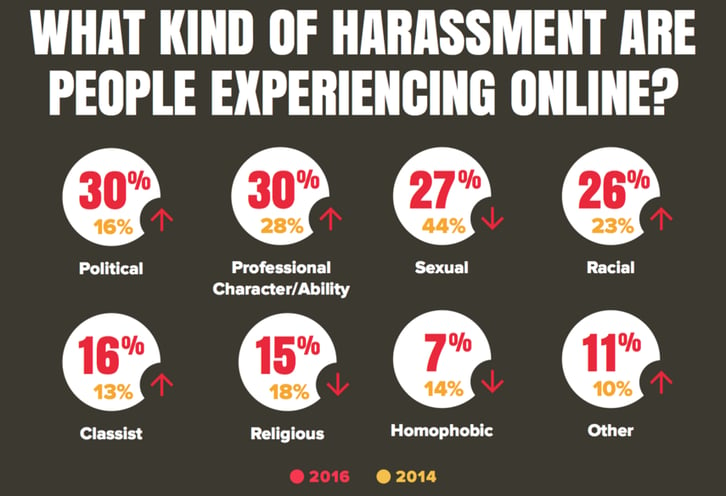Nonprofit campaigners who work on hot-button issues can struggle with community management. Dicussions on social networks can be meaningful, powerful, and even controversial. But sometimes these discussions can also attract online harassment, which can be challenging to manage.
In 2014, I helped conduct a national poll on online harassment with Craig Newmark, founder of craigslist and craigconnects, and Lincoln Park Strategies to learn more about the types of harassment people endure.
Since 2014, social networks have faced public pressure to take action and stop online harassment on their platforms. Has it worked? Our latest poll revealed that sexual harassment is down and homophobic harassment has decreased by half, but political harassment has doubled. You can view the poll data as an infographic here.

Online harassment is still a widespread issue, despite social media platforms’ implementations of policies to combat this. Take, for example, Ghostbuster 2 star Leslie Jones.
Jones had a recent experience with online harassment, particularly racist and sexist hate speech. In an interview with Seth Meyers, Jones said she teamed up with the CEO of Twitter to get several accounts shut down. Now, she’s emphasizing the differentiation between hate speech and freedom of speech.
Additionally, political harassment has increased significantly over the last 2 years -- from 16% to 30%. Boomers experience political harassment more than any other generation. More than 3/4 of adults ages 55-64 harassed online experience political harassment (79%). If your organization works on policital issues, this is critical to be aware of, and it means that you'll need to be monitoring your networks now more than ever.

So, are social networks doing enough to keep harassers out? And what should your nonprofit do to help facilitate this?
Women want stricter laws enforced to combat harassment. In 2014, we found that the same percentage of men and women (16%) thought online harassment laws were “just right.” This year, 16% of men and only 9% women are content with current laws regarding online harassment. While you can't change what social networks are doing by yourself, you can ensure that your social media platforms and your blog have Codes of Conducts that explain which comments will be deleted and why. For example, if vulgar or threatening language is used, you might ban the user and/or delete the comment. Be sure to take screenshots of this before anything is deleted so you have a record of it. It's also important to share any threats and harassment with HR so that they are aware of what's happening and can report it to the authorities. Additionally, check out 9 Tips for Nonprofit Campaigners to Deal with Online Harassment.
Here are some key findings from the 2016 poll:
- Across all platforms, Facebook is the dominant location for harassment, even among heavy Twitter users.
- Tinder users report the highest levels of online harassment. 62% of daily Tinder users (three-quarters of whom are millennials) say that they’ve been harassed online.
- Harassment is not anonymous. In almost 2 out of 3 instances (61%), respondents report knowing their harassers.
- Younger people are harassed more than older people. 47% of millennials have either personally experienced harassment, or know someone who has. This percentage remains unchanged since 2014, despite policies implemented by social networks to address this.
- Women are harassed more than men. Of adults who reported harassment in 2016, 55% are women; 45% are men. The number for women is slightly down from 2014; for men slightly up.
- Harassment via email has increased. As more people use email daily, email harassment has risen from 20% to 25% from 2014 to 2016.
As we’ve continued analyzing this trend over time, we’re seeing that eradicating online harassment once and for all isn’t going to be easy -- not much of a surprise to anyone. We need to continue encouraging social networks to institute more efficient tools and algorithms to take on online trolls. Like Leslie Jones said, there’s a difference between freedom of speech and hate speech.
What strategies has your nonprofit used to fight back against trolls and harassers in your online communities?
The poll was conducted by Craig Newmark's craigconnects initiative, Rad Campaign and Lincoln Park Strategies. 1,017 Americans ages 18 and over were polled about their experiences with online harassment. The margin of error is ±3.07 percent at the 95 percent confidence level.



COMMENTS